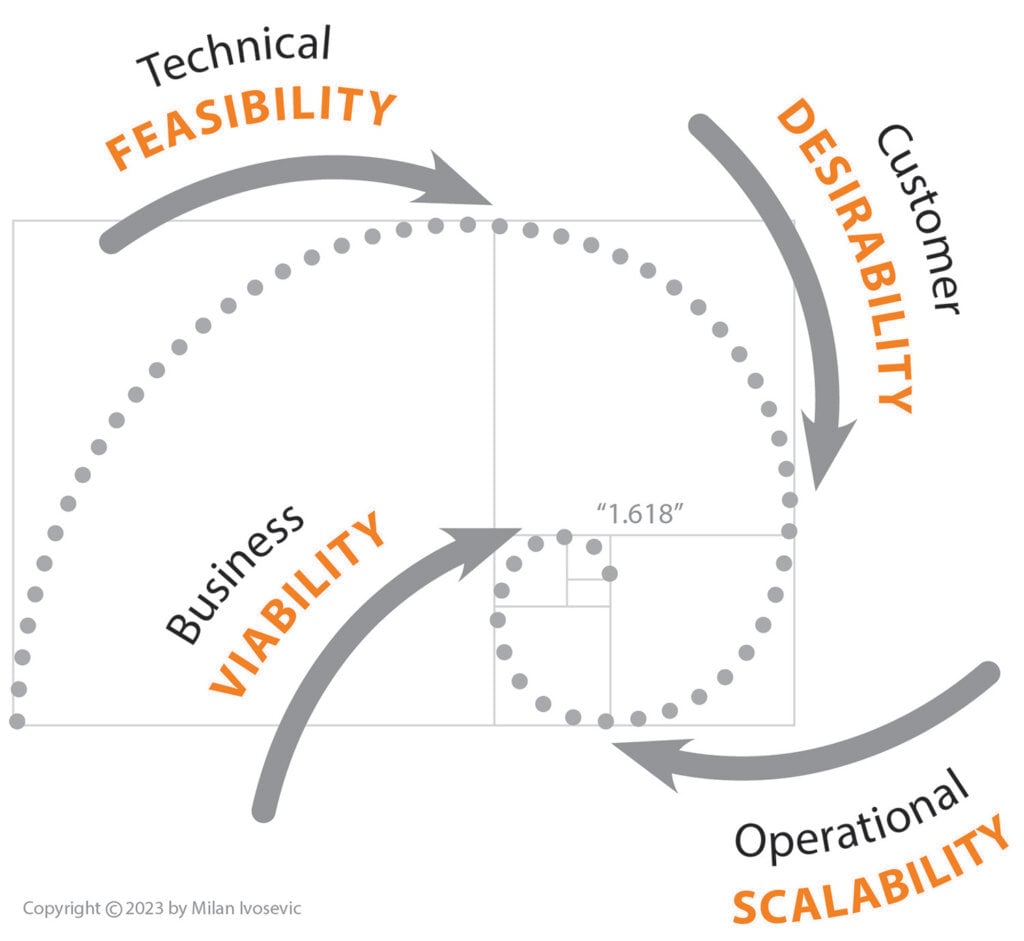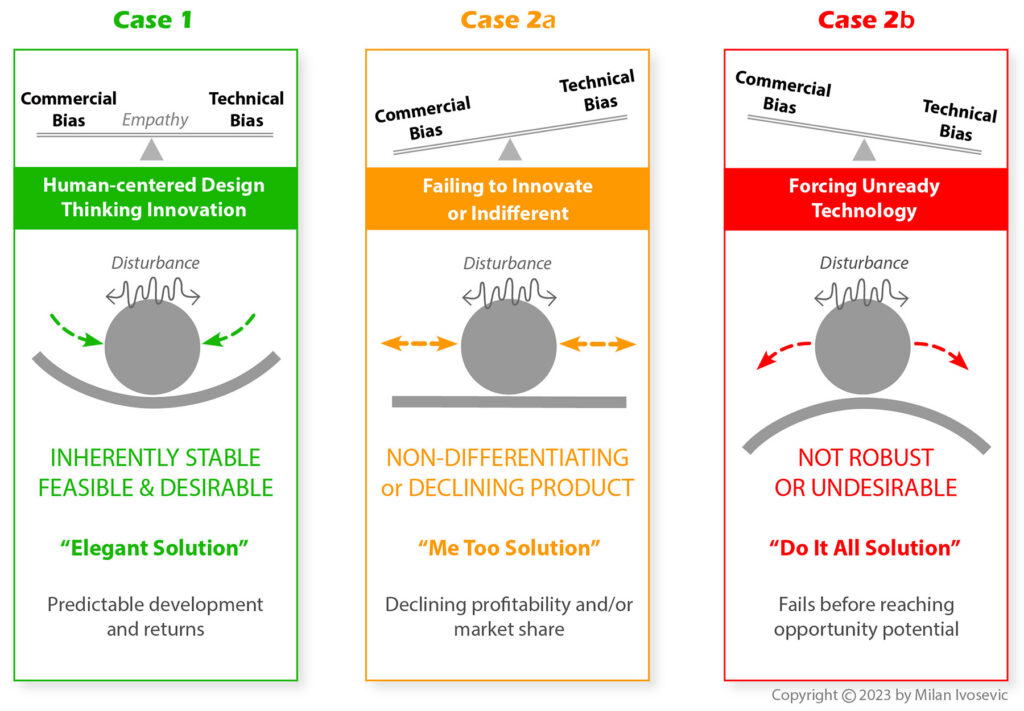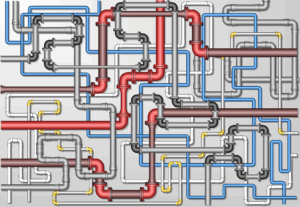“People don’t want quarter-inch drill bits, they want quarter-inch holes.”
—Theodore Levitt
We typically want to create a profitable product or service that is desirable and meets customer needs; however, we might face manufacturing cost constraints that limit our profitability or encounter scalability challenges to meet the projected demand. We usually want to create a simple, reliable product while our most promising concept might be limited by an existing patent. This list goes on and on, soon to be realized that there is a waste number of opposing “want vs. can” trade-offs that need to be balanced concurrently when creating something that is truly novel and desirable while at the same time needs to be feasible, profitable, and scalable.
Obviously, want vs. can trade-offs get exponentially more complex as our entrepreneurial aspirations get more disruptive. The steam engine, the telephone, electricity, the radio, the airplane, the transistor, the personal computer, and the Internet are just a few examples of such transformational entrepreneurial innovations. All of them have embraced the balance between the four must-have entrepreneurial innovation constituents: (i) technical feasibility, (ii) customer desirability, (iii) operational scalability, and (iv) business viability.
Desirability, feasibility, and viability pertain to design-thinking principles as described by IDEO CEO Tim Brown [1]. Operational scalability is added here as a fourth dimension that drives business growth objectives at an adequate scale in order to move the needle in large enterprises. In other words, something that could be a successful family business might not be scalable or a big enough opportunity for a large company. The divine proportion or golden ratio (1.618) was metaphorically incorporated in the graphics below to signify an elusive nature and a delicate balance between want vs. can trade-offs found in the most novel entrepreneurial innovations.

Divine harmony of entrepreneurial innovations.
Striving for the Elegant Solution
Human-centered, design-thinking principles that are rooted in deep, empathic insights in genuine user needs provide a time-tested framework for incubating desirable, elegant solutions and as such make profitability and commercial success more attainable.
Arguably, at the heart of any transformational innovation that becomes a successful business offering is a human-centered solution that creatively enables an improvement in the quality of our lives or the effectiveness of our actions. An emotional gratification and delight caused by an effective and affordable elegant solution is what often defines the success of an entrepreneurial innovation. It would be difficult to find an example of a highly successful product around us that does not embrace design-thinking principles associated with the satisfaction of people’s genuine needs as the primary driver behind its success. The following three conceptual cases illustrate the most common entrepreneurial innovation scenarios relative to the underlying commercial and technical biases.

Typical entrepreneurial innovation scenarios.
Case 1
When an entrepreneurial business offering is created under a deep, empathic, design-thinking focus on human factors and genuine user needs, we are maximizing our chances for success. We also have a better chance to achieve an elegant solution—the simplest form of an inherently stable solution that delights our customers. Simple and robust solutions are typically associated with lower development and manufacturing costs, are more scalable, and also readily contribute to profitability and the overall business prospect. Under the successful human-centered, design-thinking innovations, commercial success is often the natural output proportional to the customer satisfaction and disruptiveness of the corresponding business offering.
Case 2a
This case is typically encountered in risk-averse and defensive large organizations rather than startups where innovations are suppressed by short-term sustaining gains and a false sense of financial security under an existing business “cash cow” [2]. Such businesses operate under a strong commercial bias toward the continuity of the existing offerings. Eventually, their product differentiation diminishes or gets disrupted by a competitive move. Even new products and line extensions that come out of such an environment tend to fall into an indifferent “me too” product category.
Case 2b
This case could be encountered in both startups and established companies if they get impatient and go to the market before the product or the technology is ready. Similarly, the release of non-robust or inherently unstable solutions marketed as do-everything snake oil could bring severe harm to the company. The “fake it until you make it” business mindset often operates from a strong technical bias in this environment. The Theranos case—one of the biggest corporate technology-related frauds in history [3]—exemplifies the results of such a mindset. In contrast, Toyota with its “home first” rule demonstrates patience in the release of its new products. The company tends to evaluate and perfect new technologies internally and on the domestic market before international release.
References
[1] Brown, T. (2009). Change by design. HarperCollins Publishers.
[2] Christensen, C. M. (2016). The innovator’s dilemma: When new technologies cause great firms to fail. HBR Press.
[3] Carreyrou, J. (2018). Bad blood: Secrets and lies in a Silicon Valley startup. Alfred A. Knopf.
Editor’s Note: Selected topics from Milan Ivosevic’s book, Eureka to Wealth, will be featured as part of this Innovation Principles series in the following months:
- Introduction (Oct. ’23)
- Entrepreneurial Perspective: Human-Centered Design Entrepreneurship (Nov. ’23)
- Entrepreneurial Perspective: End to End Product Innovation Framework (Dec. ’23)
- Opportunity Incubation: The Innovation Spiral (Jan. ’24)
- Opportunity Incubation: Business Case (Sizing the Opportunity and Go / No Go check)(Feb. ’24)
- Product Delivery: Development Strategy (Mar. ’24)
- Product Delivery: Delivery Effectiveness (May ’24)
Contributor
-

Milan Ivosevic is an executive leader, entrepreneur, and innovator. From a blacksmith forge to engineering laboratories, from startups to Fortune 500 board rooms, Milan’s calling card has been his prowess in the successful commercialization of advanced technologies and new product innovations. With numerous contributions and patents in sectors ranging from advanced aerospace coatings to disruptive medical devices, his contributions have stirred market spaces and positively impacted areas such as medication management, drug delivery, blood collection, robotic surgery, and reproductive biotechnologies. In Eureka to Wealth, Milan weaves decades of value creation experience into an easily understood framework that is as valuable for executives as it is for innovation practitioners.
View all posts

















































































































































